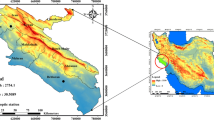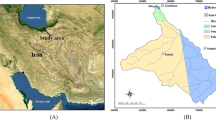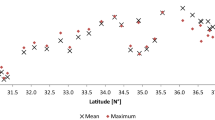Abstract
Rainfed agriculture plays an important role in the agricultural production of the southern and western provinces of Iran. In rainfed agriculture, the adequacy of annual precipitation is considered as an important factor for dryland field and supplemental irrigation management. Different methods can be used for predicting the annual precipitation based on climatic and non-climatic inputs. Among which artificial neural networks (ANN) is one of these methods. The purpose of this research was to predict the annual precipitation amount (millimeters) in the west, southwest, and south of Islamic Republic of Iran with the total area of 394,259 km2, by applying non-climatic inputs according to the long-time average precipitation in each station (millimeters), 47.5 mm precipitation since the first of autumn (day), t 47.5, and other effective parameters like coordinate and altitude of the stations, by using the artificial neural networks. In order to intelligently estimate the annual amount of precipitation in the study regions (ten provinces), feedforward backpropagation artificial neural network model has been used (method I). To predict the annual precipitation amount more accurately, the region under study was divided into three sub-regions, according to the precipitation mapping, and for each sub-region, the neural networks were developed using t 47.5 and long-time average annual precipitation in each station (method II). It is concluded that neural networks did not significantly increase the prediction accuracy in the study area compared with multiple regression model proposed by other investigators. However, in case of ANN, it is better to use a structure of 2–6–6–10–1 and Levenberg–Marquardt learning algorithm and sigmoid logistic activation function for prediction of annual precipitation.











Similar content being viewed by others
References
Afshin S, Fahmi H, Alizadeh A, Sedghi H, Kaveh F (2011) Long term rainfall forecasting by integrated artificial neural network-fuzzy logic-wavelet model in Karoon basin. Sci Res Essays 6(6):1200–1208
Chattopadhyay S, Chattopadhyay G (2007) Identification of the best hidden layer size for three-layered neural net in predicting monsoon rainfall in India. J Hydroinf 10(2):181–188
Cheng CT, Ou CP, Chau KW (2002) Combining a fuzzy optimal model with a genetic algorithm to solve multiobjective rainfall–runoff model calibration. J Hydrol 268(1–4):72–86
Diomede T, Davolio S, Marsigli C, Miglietta MM, Moscatello A, Papetti P, Paccagnella T, Buzzi A, Malguzzi P (2008) Discharge prediction based on multi model precipitation forecasts. Meteorol Atmos Phys 101(3–4):245–265
Fallah-Ghalhry GA, Mousavi-Baygi M, Habibi Nokhandan M (2009) Annual rainfall forecasting by using Mamdani fuzzy inference system. Res J Environ Sci 3(4):400–413
Fletcher R (1987) Practical methods of optimization, 2nd edn. Wiley, Chichester
French MN, Krajewski WF, Cuykendall RR (1992) Rainfall forecasting in space time using a neural network. J Hydrol 137:1–31
Ghasemi MM, Sepaskhah AR (2004) Prediction of annual precipitation in Khuzestan province based on early rain events in fall. J Sci Technol Agric Nat Res 8:1–10 (In Persian)
Guhathakurta P (2008) Long lead monsoon rainfall prediction for meteorological sub divisions of India using deterministic artificial neural network model. Meteorol Atmos Phys 101(1–2):93–108
Gwangseob K, Ana PB (2001) Quantitative flood forecasting using multi-sensor data and neural networks. J Hydrol 246:45–62
Hunda AKS (1994) Management strategies to minimise climatic risk to wheat production in low rainfall areas of southern Australia. Agric For Meteorol 59:125–127
Hung NQ, Babel MS, Weesakul S, Tripathi NK (2009) An artificial neural network model for rainfall forecasting in Bangkok, Thailand. Hydrol Earth Syst Sci 13:1413–1425
Kang S (1991) An investigation of the use of feedforward neural networks for forecasting. Ph.D. thesis, Kent State University
Kehl M (2009) Quaternary climate change in Iran—the state of knowledge. Erdkunde 63(1):1–17
Khalfaoui JLB (1991) Determination of potential length of the crop growing period in semi-arid region of Senegal. Agric For Meteorol 55:251–263
Kumarasiri AD, Sonnadara DUJ (2006) Rainfall forecasting: an artificial neural network approach. Proc Tech Sess 22:1–13
Li F, Zeng QC (2008) Statistical prediction of East Asian summer monsoon rainfall based on SST and sea ice concentration. J Meteorol Soc Jpn 86(1):237–243
Li XY, Chau KW, Cheng CT, Li YS (2006) A web-based flood forecasting system for Shuangpai region. Adv Eng Softw 37(3):146–158
Lin JY, Cheng CT, Chau KW (2006) Using support vector machines for long-term discharge prediction. Hydrol Sci J 51(4):599–612
Lin GF, Chen GR, Wu MC, Chou YC (2009) Effective forecasting of hourly typhoon rainfall using support vector machines. Water Resour Res 45:W08440
Mar KW, Naing TT (2008) Optimum neural network architecture for precipitation prediction of Myanmar. World Acad Sci Eng Technol 48:130–134
Munot AA, Kumar KK (2007) Long range prediction of Indian summer monsoon rainfall. J Earth Syst Sci 116(1):73–79
Muttil NA, Chau KW (2007) Machine learning paradigms for selecting ecologically significant input variables. Eng Appl Artif Intell 20(6):735–744
Nayagam LR, Janardanan R, Mohan HSR (2008) An empirical model for the seasonal prediction of southwest monsoon rainfall over Kerala, a meteorological subdivision of India. Int J Climatol 28(6):823–831
Nnaji AO (2001) Forecasting seasonal rainfall for agricultural decision-making in northern Nigeria. Agric For Meteorol 107:193–205
Rees DJ, Samiullah A, Rehman F, Kidd CHR, Keatinge JDH, Raza SH (1990) Precipitation and temperature regimes in upland Balochistan: their influence on rain-fed crop production. Agric For Meteorol 52:381–396
Rees DJ, Omar AM, Rodol O (1991) Implication of the rainfall climate of southern Somalia for semi-mechanized rain-fed crop production. Agric For Meteorol 56:21–33
Reilly DL, Cooper LN (1990) An overview of neural networks: early models to real world systems. In: Zornetzer SF, Davis JL, Lau C (eds) An introduction to neural and electronic networks. Academic, New York, pp 227–248
Rogers RR, Yau MK (1989) A short course in cloud physics. Pergamon, Oxford, 293 pp
Sepaskhah AR, Taghvaie AR (2004) A simple model for prediction of annual precipitation in the southern and western provinces of I. R. Iran. Iran Agric Res 23:1–12
Sharda R, Patil RB (1992) Connectionist approach to time series prediction: an empirical test. J Intell Manuf 3:317–323
Sheng C, Gao S, Xue M (2006) Short-range prediction of a heavy precipitation event by assimilating Chinese CINRAD-SA radar reflectivity data using complex cloud analysis. Meteorol Atmos Phys 94(1–4):167–183
Sivakumar MVK (1988) Predicting rainy season potential from the onset of rain in the southern Sahelian and Sudanian climatic zone of West Africa. Agric For Meteorol 42:295–305
Sivakumar MVK (1990) Exploiting rainy season potential from the onset of rain in the Salelian zone of West Africa. Agric For Meteorol 51:321–332
Stewart JI (1986a) Mediterranean-type climate, wheat production and response farming. In: Whitman CE, Parr JF, Papendick RI, Meyer RE (eds) Soil, water and crop/livestock management systems for rainfed agriculture in the Near East Region. Proce. Workshop at Amman, Jordan, Jan. 18–23. US Department of Agriculture, Washington, DC, pp 5–19
Stewart JI (1986b) Response farming for improvement of rainfed crop production in Jordan. In: Whitman CE, Parr JF, Papendick RI, Meyer RE (eds) Soil, Water and Crop/Livestock Management Systems for Rainfed Agriculture in the Near East Region. Workshop at Amman, Jordan, Jan. 18–23. US Department of Agriculture, Washington, DC, pp 288–306
Tang Z, Fishwick PA (1993) Feedforward neural nets as models for time series forecasting. ORSA J Comput 5(4):374–385
Weesakul U, Lowanichchai S (2005) Rainfall forecast for agricultural water allocation planning in Thailand. Thammasat Int J Sci Tech 10(3):18–27
Widrow B, Rumelhart DE, Lehr MA (1994) Neural networks: applications in industry, business and science. Commun ACM 37(3):93–105
Wu CL, Chau KW, Fan C (2010) Prediction of rainfall time series using modular artificial neural networks coupled with data pre-processing techniques. J Hydrol 389(1–2):146–167
Yu Z, Chu P, Schroeder T (1997) Predictive skills of seasonal to annual variations in the U.S. affiliated Pacific Islands: canonical correlation analysis and multivariate principle component regression approaches. J Clim 10:2586–2599
Acknowledgments
This research was supported in part by grant no. 90-GR-AGR-42 of Shiraz University Research Council, Drought National Research Institute, and Center of Excellence on Farm Water Management.
Author information
Authors and Affiliations
Corresponding author
Rights and permissions
About this article
Cite this article
Azadi, S., Sepaskhah, A.R. Annual precipitation forecast for west, southwest, and south provinces of Iran using artificial neural networks. Theor Appl Climatol 109, 175–189 (2012). https://doi.org/10.1007/s00704-011-0575-9
Received:
Accepted:
Published:
Issue Date:
DOI: https://doi.org/10.1007/s00704-011-0575-9




